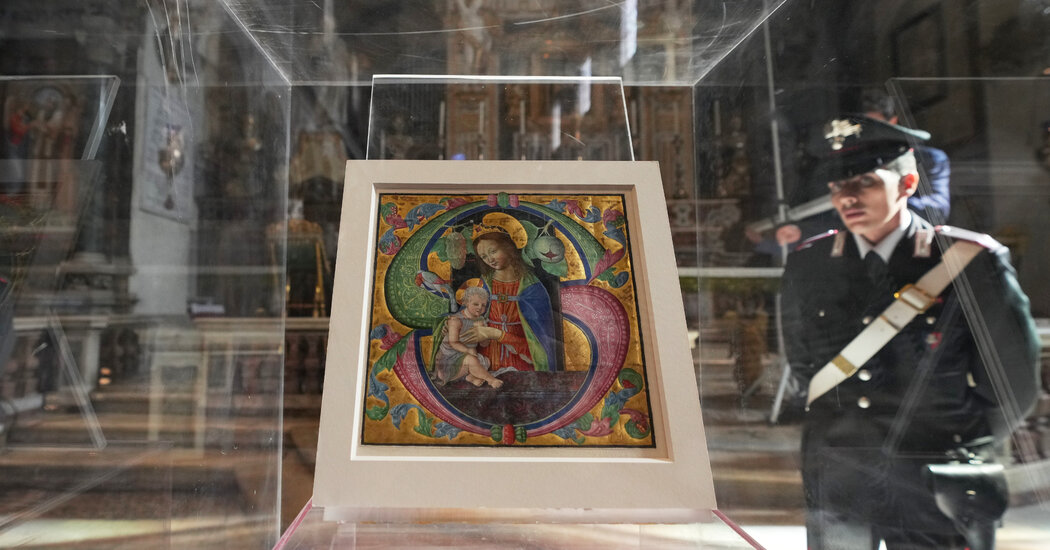Sleuths from the crack art theft police squad in Italy still have not figured out how, some 40 years ago, thieves stole a cache of pages from a 15th-century choir book housed in a Franciscan friary in Rome. Nor do they know whodunit.
But when a page from the manuscript appeared on the website of a London auction house in February, the police managed to block the sale and return the work. On Wednesday, the miniature depicting the “Virgin and Child” was officially reunited with its owner, a friary abutting Santa Maria in Aracoeli, a much-refurbished medieval church that looms above a steep flight of stairs on Rome’s Capitoline Hill.
The recovery required “channels of cooperation” involving police forces, prosecutors and diplomats in several countries, Gen. Antonio Petti, the commander of the Carabinieri police branch specializing in art crime, said at a restitution ceremony at the church.
The return of the manuscript page offered a counterpoint to the Louvre jewelry heist in Paris that has raised questions about security measures at one of the world’s most famous museums.
Pages from manuscripts are especially tempting to thieves because they can easily be removed from books, transported and — as in the case of exquisitely decorated images like “Virgin and Child” — sold as if they were small paintings, said Alessandra Acconci, an official with the state art authorities in Rome.
“An occasion like today is a reminder of that,” she said at the return on Wednesday.
Even the Vatican Library has had its fair share of nimble-fingered visitors, including one who stole a letter written by Christopher Columbus by substituting the original with a fake, allowing it to go unnoticed for years. In 2012, police officials discovered that an entire library in Naples had been systematically plundered of its tomes.
The “Virgin and Child” is by Fra Antonio da Monza, a Franciscan friar and a renowned manuscript illuminator who worked for the court in Milan and for the Borgia pope, Alexander VI, during the final decades of the 15th century and the first years of the 16th century.
The page had been stolen from a choir book in the Aracoeli friary in the early 1980s, along with an unknown number of other books and pages, investigators said. Brother Luciano De Giusti, the provincial head of the branch of Franciscans who occupy the friary, said that security measures had been lax at the time, and many works could have gone missing.
In 1987, Carabinieri officers patrolling a flea market in a town outside Milan found several pages belonging to a manuscript that they eventually traced to the Aracoeli, said Col. Paolo Befera, who oversees operations for the Carabinieri art theft squad. “The pages were being sold as material to make lampshades,” he said.
The trail had gone cold for the “Virgin and Child” until earlier this year, when a London auction site posted a photo of the image on its website for an upcoming auction. It matched with a photo on the Carabinieri’s voluminous database of stolen art. The sleuths alerted the auction house, which convinced the owners to return the work to Italy, and to the friary, Colonel Befera said.
Though celebrated, the recovery of the page was a small consolation for the church, which in 1994 was the site of one of Italy’s most brazen art thefts.
That February, thieves used scaffolding to get inside and steal a revered and richly decorated 15th-century wooden statue of the infant Jesus, known as the bambinello, which was one of Rome’s most revered art pieces.
Legend has it that the work was sculpted by angels out of olive wood from Jerusalem’s Garden of Gethsemane, and that it miraculously survived a shipwreck when it was brought to Rome from the Holy Land. Along with Caravaggio’s “Nativity,” stolen from a Sicilian oratory in 1969, and a Cézanne work stolen from a Rome museum in 1992, the sculpture remains on the list of the most wanted missing artworks in Italy.
“The bambinello is another story, and we’re still looking,” Colonel Befera said. “We’re patient. Sooner or later, things emerge.”
Elisabetta Povoledo is a Times reporter based in Rome, covering Italy, the Vatican and the culture of the region. She has been a journalist for 35 years.
The post Four Decades After It Was Stolen, a Renaissance Treasure Returns to Rome appeared first on New York Times.




